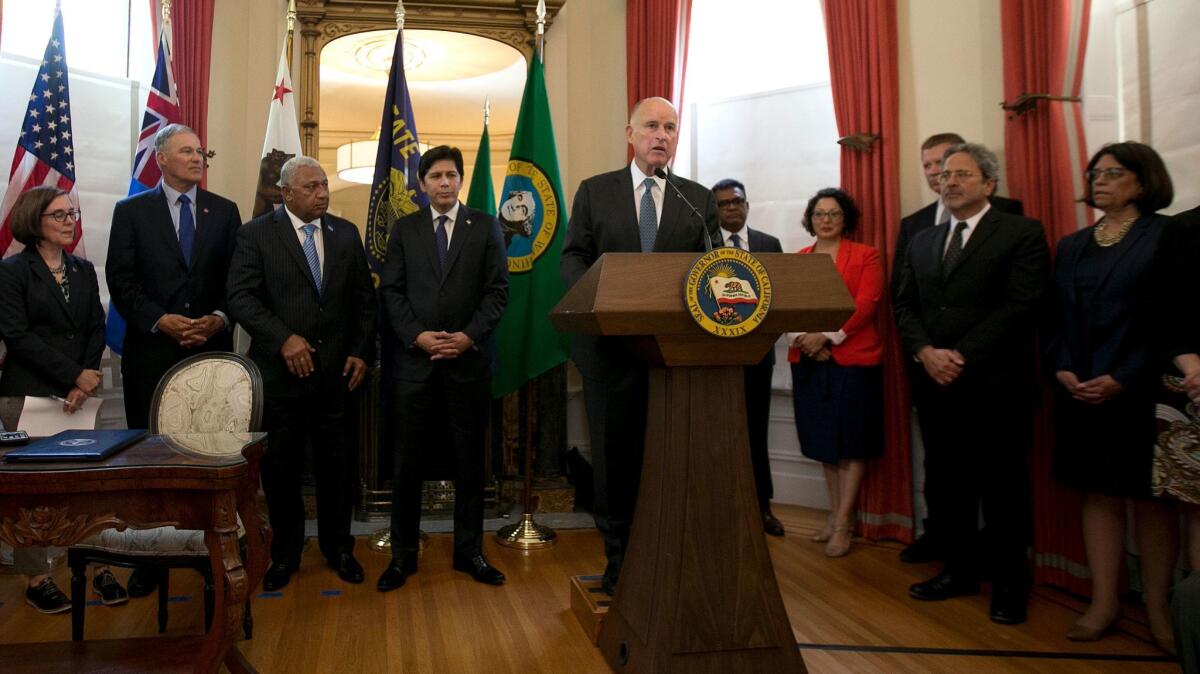Editorial: Trump is dropping out of the Paris agreement, but the rest of us don’t have to

- Share via
The gap between President Trump’s climate change policy and the science-based needs of the world grows wider by the day. But if there’s a silver lining to the president’s rash and dangerous decision to withdraw the U.S. from the Paris climate agreement, it’s that it has reinvigorated the environmental ambitions of a wide range of local, state and foreign governments, as well as businesses — persuading them not only to carry on with their existing efforts to reduce carbon emissions, but to create broad coalitions to achieve even bigger gains.
You could see the manifestation of that in the photos of California Gov. Jerry Brown sitting recently with Chinese President Xi Jinping in Beijing, discussing ways California can work with China, the world’s biggest carbon emitter, to reduce greenhouse gases. Trump’s policy be damned, the picture implies; the American people will continue to work with the rest of the world.
State and local governments — with the assistance of forward-looking market forces — already were reducing emissions when Trump won the White House. Brown’s Under2 MOU, a 2015 agreement of subnational governments around the world to reduce emissions, now has more than 170 signatories representing more than 1.1 billion people and 39% of the global economy. Nearly 300 U.S. mayors, led in part by L.A. Mayor Eric Garcetti, have joined together to reduce carbon emissions within their jurisdictions. Businesses have been moving in a similar direction.
Local and state governments are economic engines that can expand demand for renewable energy by helping drive down the costs for nongovernmental consumers.
These are more than “Kumbaya” steps. Local and state governments are economic engines that can expand demand for renewable energy by helping drive down the costs for nongovernmental consumers. This is one way around Trump’s fossil fuel-burning agenda. In March, Los Angeles joined 30 other cities in asking the automotive industry about the feasibility of buying a combined 114,000 electric vehicles for their fleets, a potential $10-billion deal that would reduce city fleet emissions and drastically expand the market for such vehicles. Last year, only 159,139 electric vehicles were bought, a tiny fraction of the 17.55 million total vehicles sold.
California and 10 other states already have a mandate in place setting specific goals and applying pressure to auto manufacturers to increase sales of zero-emissions vehicles. In another arena, the Los Angeles Department of Water and Power announced last week that it is postponing a $2.2-billion investment in renovating aging natural gas-fired power plants in the face of a statewide supply glut, and that it would search out renewable sources to help meet a state mandate that half of California’s electricity must come from clean energy sources by 2030. At the same time, Senate leader Kevin de León (D-Los Angeles) is seeking to push that mandate to 100% renewables by 2045.
Of course, setting goals is one thing and meeting them is another. But even officials with firms such as Sempra, which is heavily involved in natural-gas power generation, and the California Independent System Operator, which oversees about 80% of the state power system, see the 100% renewables goal as attainable.
It’s not just California making these inroads. Washington recently announced a plan to make at least 20% of its state fleet of motor vehicles electric-powered. Houston, of all places, is the nation’s largest municipal user of renewable energy, with wind and solar providing 89% of its power. Minneapolis works with two investor-owned utilities to analyze usage data and target energy-saving programs to non-complying buildings. Across the Pacific, smog-choked Beijing is looking to replace nearly 70,000 taxis with electric vehicles.
Businesses have taken steps too, recognizing that there is money to be made and saved through reduced carbon emissions. Many major corporations publicly lobbied Trump to remain in the Paris agreement, arguing that their interests are “best served by a stable and practical framework facilitating an effective and balanced global response.”
What subnational governments and corporations do now could have a significant impact on where the world winds up (businesses could help more if they stopped donating to the campaigns of climate-skeptic politicians). Yes, much more needs to be done and the effort would be far more effective if it were made in tandem with the U.S. government. But that Trump has turned his back on a habitable planet doesn’t mean the rest of us should. Or can.
Follow the Opinion section on Twitter @latimesopinion or Facebook
More to Read
A cure for the common opinion
Get thought-provoking perspectives with our weekly newsletter.
You may occasionally receive promotional content from the Los Angeles Times.










